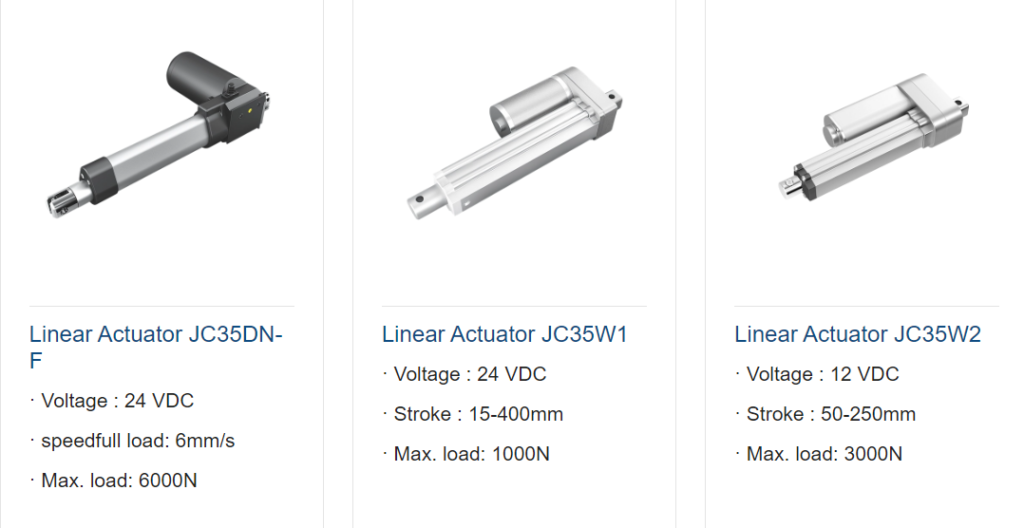A linear actuator is an essential device used in various industries and applications to convert rotational motion into linear motion. It is commonly used when precise control, stability, and automation are needed in lifting, positioning, or moving objects. As technology advances, the demand for high-quality linear actuators is growing in industries such as healthcare, automotive, industrial automation, and home automation. In this article, we will explore what a linear actuator is, its types, and its applications, while also recommending JIECANG’s top-notch linear actuators for a wide range of uses.
What is a Linear Actuator?
A linear actuator is a mechanical device designed to move or position objects along a straight line. Unlike rotary actuators that rotate objects, linear actuators provide motion along a linear path. This makes them ideal for tasks that require precision, such as opening windows, adjusting hospital beds, or operating industrial machinery.
Linear actuators come in different forms, including hydraulic, pneumatic, and electric models. However, electric linear actuators have become increasingly popular due to their energy efficiency, ease of control, and integration with automation systems. Electric linear actuators are powered by motors and can be controlled using various mechanisms, including remote controls, sensors, and programmable logic controllers (PLCs).
Types of Linear Actuators
There are several types of linear actuators, each suited to specific tasks:
Electric Linear Actuators: These are powered by electric motors and are known for their precision and ease of control. They are commonly used in applications like adjustable furniture, medical devices, and automation systems.
Hydraulic Linear Actuators: Hydraulic actuators use fluid pressure to create motion. They are strong and can handle heavy loads, making them ideal for industrial applications requiring high force.
Pneumatic Linear Actuators: Pneumatic actuators use compressed air to produce linear motion. They are often used in lightweight applications where fast movement is required.
Telescopic Actuators: These actuators extend and retract in a telescoping manner, allowing for compact designs with longer strokes.
Applications of Linear Actuators
Linear actuators are used in a wide array of industries, offering versatility and precision in different fields:
Healthcare: Linear actuators are widely used in hospital beds, patient lifts, and dental chairs, where smooth and accurate movement is required for patient comfort and safety.
Home Automation: In modern homes, linear actuators are integrated into systems for adjustable desks, automated windows, and smart furniture to enhance convenience and comfort.
Automotive Industry: Electric linear actuators are found in car seats, sunroofs, and power windows, allowing for smooth adjustments and positioning.
Industrial Automation: In factories and warehouses, linear actuators play a critical role in controlling conveyors, packaging machines, and robotic arms.
Renewable Energy: Solar panel tracking systems utilize linear actuators to adjust the panels’ angles throughout the day for optimal energy capture.
Advantages of Linear Actuators
Linear actuators provide several benefits in comparison to other motion control devices:
Precision: Electric linear actuators, in particular, offer accurate control over the movement, ensuring that tasks such as positioning and lifting are done with high precision.
Low Maintenance: Electric actuators generally require less maintenance than hydraulic and pneumatic systems, making them cost-effective over time.
Energy Efficiency: Electric actuators consume less energy, especially in applications that require sustained motion or frequent adjustments.
Quiet Operation: Electric actuators tend to operate more quietly, which is crucial in environments such as hospitals, offices, and residential settings.
Customization: Linear actuators can be customized to specific strokes, load capacities, and speeds to meet the needs of various applications.
Why Choose JIECANG’s Linear Actuators?
When it comes to reliable and high-performance linear actuators, JIECANG is a leading name in the industry. JIECANG’s linear actuators are known for their cutting-edge technology, durability, and precision. Here’s why JIECANG’s linear actuators stand out:
Advanced Technology: JIECANG’s linear actuators are built with the latest motor technologies, ensuring smooth, precise, and efficient linear motion. Their actuators can easily be integrated into automation systems, offering maximum control.
Durability: JIECANG products are engineered with high-quality materials, ensuring long-term durability, even in demanding environments such as factories or hospitals.
Wide Range of Applications: Whether you need actuators for medical equipment, industrial machinery, or home automation, JIECANG offers a variety of linear actuators to meet your specific needs.
Customization Options: JIECANG provides customizable linear actuators, allowing users to select the appropriate stroke length, load capacity, and speed to suit their application.
Customer Support: With years of industry experience, JIECANG offers excellent customer service, ensuring that their clients receive the right product for their requirements and technical support when needed.
Conclusion
Linear actuators have revolutionized motion control across a variety of industries, offering precision, reliability, and efficiency. Whether in healthcare, home automation, or industrial automation, linear actuators play a vital role in creating smooth and accurate motion. For those seeking a top-tier solution, JIECANG’s linear actuators offer the perfect combination of advanced technology, durability, and customization. With JIECANG, you can be confident in finding the ideal actuator for your specific application, whether it’s for an industrial setting or a home project.
For more information about Linear actuator, please visit our official website https://www.jiecang.com/

